The significance of the discovery lies in the fact that the shape of children’s faces may indicate health and developmental issues.
A study using AI and deep learning techniques has linked maternal alcohol use before and throughout pregnancy to facial morphology changes in offspring.
The findings of the study were published in the journal Human Reproduction today. It is the first to find this link among the offspring of moms who drank up to three months before getting pregnant but abstained throughout pregnancy.
Additionally, it was shown that the link between alcohol consumption and changed facial shape persisted even in moms who consumed less than 12g of alcohol per week, or around a tiny, 175 ml glass of wine or 330 ml of beer.
The discovery is significant since children’s faces may serve as indicators of developmental and health issues.
“I would call the face a ‘health mirror’,” remarks lead author Gennady Roshchupkin, “as it reflects the overall health of a child.
Foetal alcohol spectrum disorder (FASD) is visible in children’s faces and may have serious consequences for their health and development if they were exposed to alcohol during pregnancy from a mother who habitually drank excessively.
The hallmarks of FASD include a failure to reach expected height and weight milestones and the manifestation of these conditions in a distinctive pattern of facial abnormalities.
Cognitive impairment, attention deficit hyperactivity disorder (ADHD), learning challenges, memory issues, behavioral issues, and speech and language impairments are some of the symptoms.
It’s previously established that maternal alcohol use, especially excessive consumption, during pregnancy causes FASD in offspring. The impact of minimal alcohol intake on children’s face development and, by extension, their health, was not well understood until recently. Additionally, this is the first research to look at the issue among kids from various ethnic origins.
The researchers analyzed three-dimensional images of children aged nine (3149 children) and thirteen (2477 children) using AI and deep learning. The children were a part of the Generation R Study, a population-based investigation on pregnant women and their offspring from the time of conception forward. The kids in this study were born from April 2009 to January 2006.
“The face is a complex shape and analysing it is a challenging task. 3D imaging helps a lot, but requires more advanced algorithms to do this,” explains Prof. Roshchupkin. “For this task, we developed an AI-based algorithm, which takes high-resolution 3D images of the face and produce 200 unique measurements or ‘traits’. We analysed these to search for associations with prenatal alcohol exposure and we developed heat maps to display the particular facial features associated with the mother’s alcohol consumption.”
In the beginning, middle, and end of their pregnancies, the women filled out questionnaires about how much alcohol they drank.
The mothers were split into three groups by the researchers: those who did not drink before or during pregnancy (the control group), those who drank for three months prior to conception but stopped when they became pregnant, and those who drank while pregnant—including those who only drank in the first trimester and those who drank all the way through.
In the nine-year-old children, they discovered a statistically significant relationship between prenatal alcohol consumption and facial shape. The moms’ alcohol use increased the statistical significance of the changes. The turned-up nose tip, shorter nose, turned-out chin, and turned-in lower eyelid were the most prevalent characteristics, according to the first author Mr. Xianjing Liu.
“Among the group of mothers who drank throughout pregnancy, we found that even if mothers drank very little during pregnancy, less than 12 g a week, the association between alcohol exposure and children’s facial shape could be observed. This is the first time an association has been shown at such low levels of alcohol consumption.”
When the researchers examined the data for the children at the age of 13, the relationship between alcohol intake and face shape diminished in the older children and no meaningful association was seen.

It’s likely that these differences may diminish or be covered up by typical development patterns when a child gets older and encounters other environmental variables. However, it does not follow that alcohol’s detrimental effects on health will likewise vanish. In order to guarantee the best possible health results for both the mother and the growing fetus, Prof. Roshchupkin emphasized that there is no known safe amount of alcohol intake during pregnancy and that it is thus advised to stop drinking even before conception. To completely comprehend how the relationship forms and then decreases with age, further research on the process of association is required.
When researchers compared moms who drank before to getting pregnant but quit when they were pregnant with those who kept drinking throughout pregnancy, they discovered statistically significant facial characteristics were linked to mothers’ alcohol intake in the nine-year-olds.
They also examined data for first-trimester drinkers who later quit drinking as well as those who persisted. The findings were consistent, suggesting that the correlations were explained mostly by the foetus’s exposure to alcohol during the first three months of pregnancy.
According to the researchers, previous studies of child development following prenatal alcohol exposure have suggested that potential mechanisms of action may be metabolic disorders in the mothers, such as issues with blood sugar levels and fatty liver disease, and that this could also account for the link with the face shape. However, further research is required.
A strong point of the study is that it looked at a lot of children from different ethnic groups.
Limitations include the lack of information about alcohol intake more than three months before conception and the possibility that women may not have accurately answered the questionnaire about their drinking habits, which might have resulted in an underestimation of consumption.
This research is an observational one, therefore it cannot prove that drinking alcohol causes changes in face shape; rather, it can only demonstrate that they are related to it.
Source: 10.1093/humrep/dead006
Image Credit: Getty
